Fighting in Fairyland: Back on the Horror Beat
The Agony Column for May 28, 2002
Commentary by Rick Kleffel
I'll admit that I never stray too far from horror fiction. This is
because to me it seems to offer all the best attributes of a genre.
Horror fiction is usually about pretty down-to-earth characters but
allows the writer some great tools for imaginatively exploring those
characters and their relationships to one another and the world about
them. The two last horror novels I read, James Herbert's 'Once...'
and Simon R. Green's 'Drinking
Midnight Wine' offer up a nice miniature of the horror spectrum,
and have some small amount of similarity. They both use big chunks of
children's fairy tales, and traditional fairy tales, and spin them in
a horrific fashion. Both recall to some extent one of the earliest
attempts to do this, Raymond E. Feist's 'Faerie Tale'. If you're
interested in fairy tale horror, these books might be a place you
want to look.
Yes, we all know that fairy takes are the original horror stories,
and like many horror stories, they intend to teach by example. But
each of the three authors of the novels in question takes some pretty
serious liberties in the Fairy Tale department. And each of them
comes up with a result of varying success. Nope, this column isn't
going to be the usual Rick Kleffel 'Gosh I sure love all those books'
festival. Sorry about that.
When I originally started thinking about this column, I talked to
a friend my subject, which I then called 'fairy tale horror'. She
replied to me that my idea sounded interesting, and then proceeded to
rattle off her experiences with this sub-genre so expertly and in
such detail that I was rather take aback. How could I do this? But
like the reviewer in Stanislaw Lem's 'Pericalypsis' from 'A Perfect
Vacuum': "...going by the title of the book, the English
introduction, and a few understandable expressions here and there in
the text, he has concluded that he can pass muster as a reviewer
after all."
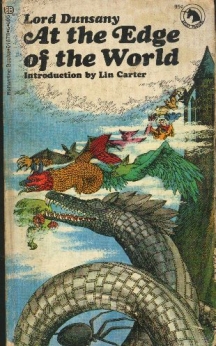
|
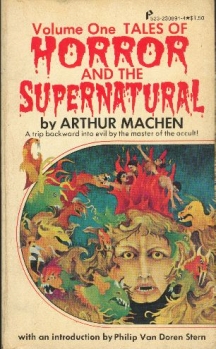
|
|
Who could count the young minds permanently damaged by
Lin Carter's prestigious series of Adult Fantasy re-releases
of the late 1960's and early 1970's?
|
I read Arthur Machen in this edition just after
escaping Covina High School. 'The White People' is still one
of my all-time favorite horror stories.
|
Fairy
tales do have along history in horror fiction. Machen, Dunsany -- and
now these gents. Let's ignore the past and focus on the present. The
first of these works to come into my purview was Raymond E. Feist's
'Faerie Tale'. I can still summon the memory of buying it at the
Crown Books on Pacific Coast Highway in Redondo Beach, California.
Crown was a new store and new idea at the time, which would be 1988.
It was one of those instant-buy books -- I saw it and I bought it,
loving the cover, concept, knowing nothing about Feist except that he
had written some fantasy. I was pretty much a solid horror fan back
then, enraptured by Barker, Campbell, Simmons and the whole
splatterpunk wave of creative horror that was NOT taking the nation
by storm.
I was also a fan of fairy-oriented horror fiction, in particular
Machen's 'The White People', which still stands towering over much of
anything else that might dare to call itself fairy-tale oriented
horror. I was perfectly primed, a bullet in the chamber aimed and
ready to shoot. I liked the cover art. It promised monsters. I bought
the book.
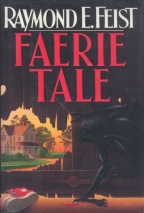
|
|
I read Raymond Feist in 1988, as the world spiralled
down the Big Swirly. But some things bob back up....
|
Fourteen years have passed since I read 'Faerie Tale'. I remember
it vividly. The premise is simple, but promising. Philip Hastings and
his family have pulled up their California roots and headed back east
to Lovecraft country -- or thereabouts. They've bought the Old
Kessler Place, built on Erl King Hill. Philip has just come away from
authoring a series of films remarkably like 'Star Wars', his wife
Gloria is an Oscar winning actress, he has beautiful twin boys and a
gorgeous teenage girl. They're ultra-rich, super-talented and fairly
famous. They're looking to make a new start, away from the hustle and
bustle of California. Alas, you buy any abode, the name of which
conforms to the template 'Old [Name] Place', located on
'[Name] King Hill', you better have ghost and alien abduction
insurance. They didn't actually have alien abduction insurance back
then, as the Anal Probe Brigade hadn't yet been heard of at Harvard.
But I bet these folks could have gotten Ghostbusting coverage, and
had they just paid attention to genre literature, they certainly
would have. It's clear they're headed for trouble.
As I read the novel, I still to this day remember my realization
that, for this family, Trouble Can't Come Fast Enough. I got an
immediate and allergic reaction to Gloria who only needs to get to
page 8 before she exclaims '"This is not what Oscar Winners are
supposed to be doing! Phil!"' This is still in the sympathy-building
stages, but it had the opposite effect on me. I'll admit it though, I
like my characters to have some flaws. Rich, famous, beautiful,
talented -- Feist might as well have made them Neo-Nazi torturers as
far as I was concerned. The Hastings was a family that Could Not Die
Fast Enough.
Now, I'll give Feist a bit of credit where the monsters go. He at
least actually read some bits of various legends here and there.
There are some nice moments of monster menace. He can string
grammatical sentences together, one after another, describe coherent
scenes, do all the things that add up to 418 pages of Book. The
Faerie monsters are imported from any number of better-written works
and seem merely uninspired.
I think however, in this particular work (I've read nothing
since), he got the whole black and white thing mixed up a bit. Black
is the print, white is the page. In the 1990's, with the explosion of
the World Wide Unreadable Web, things have gotten a bit more varied,
mostly to the detriment of those attempting to decipher puce type on
a brown background. Back to Black and White. It's supposed to be for
the type only, not the characters. Feist's characters in 'Faerie
Tale' are so monochromatically good that they annihilate any interest
the reader might attempt to bring to the book. By the novel's
conclusion, I was ready to make the trek from sunny California with a
bucket of sewage to rain these relentlessly cheerful characters. But
you know what happened? I just didn't care.
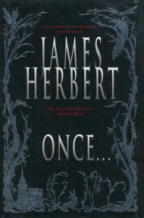
|
|
Tor put together a classy package for James Herbert's
'Once...'.
|
The same cannot be said for the main character of James Herbert's
remarkably similar 'Once...'
now out from Tor. Before I get out the scalpel, let me take a minute
to praise effusively the remarkable package that Tor has put together
for this novel. It has a very classy cover that might suck you in
even if you've never read (or didn't enjoy) 'Rats'. But open it up.
Inside on the endpapers are some of the nicest paintings I've ever
seen, four of them, beautifully printed. The registration is perfect.
The binding is such that you can actually see them. For some insane
reason, they're totally uncredited, at least, in so far as I can
find, and I've looked several times. Once....you're inside the book,
you'll notice a very nicely printed and drawn title page, map, and
chapter headings. It's the kind of thing you often only see in
small-press limited editions, very well done. Congratulations to Tor
for a job well done. It's something I'd love to see them continue,
and I have to admit that it did factor into me shelling out $26.95,
plus California's sales tax for the novel.
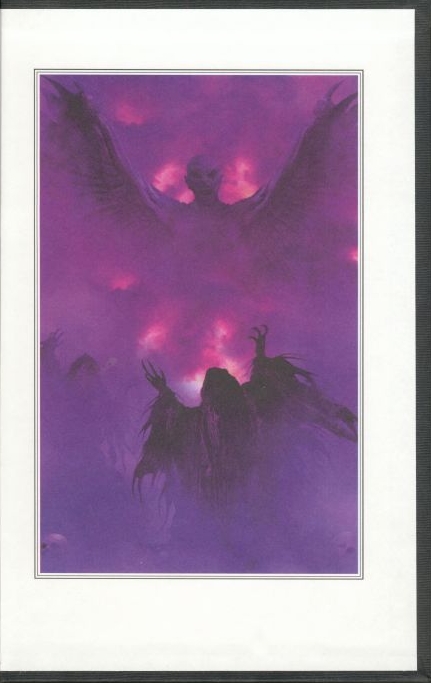
|
|
The endpapaer from Tor's version of James Herbert's
'Once...' WARNING: These endpapers are not found on the UK
version. For once, the US publisher added something to the
package, and improved the art direction
immeasurably.
|
If you're worried that the reviewer is praising the package but
hasn't yet got round to the novel itself, it's with good reason. The
premise of this novel is remarkably similar to the premise of 'Faerie
Tale'. Guy moves into an old house, the Fairies come out both erotic
and psychotic, make his life a mess. Now, it's only one guy, however,
and he's moving back into the house he grew up in as a kid. So this
novel isn't just a rewrite, but the similarity was so strong that I
actually took 'Faerie Tale' off the shelf and looked at it. Given my
thoughts above, one can imagine that this took some doing.
Fortunately, in 'Once...', the reader is at least given the crumb
of a good character to enjoy. Thom Kindred is a 27-year-old man who
is recovering from a stroke. He is pretty crippled, and fairly
nervous. I like that in a character. Much of what follows is fairly
well-written, though nobody is going to quote Herbert in book reviews
to illuminate the inner torments of the woodcutter, Thom's
occupation. Herbert can set a scene of tension and carry it out well.
He can also describe landscapes and move his characters though them
in a way the casual reader can easily visualize.
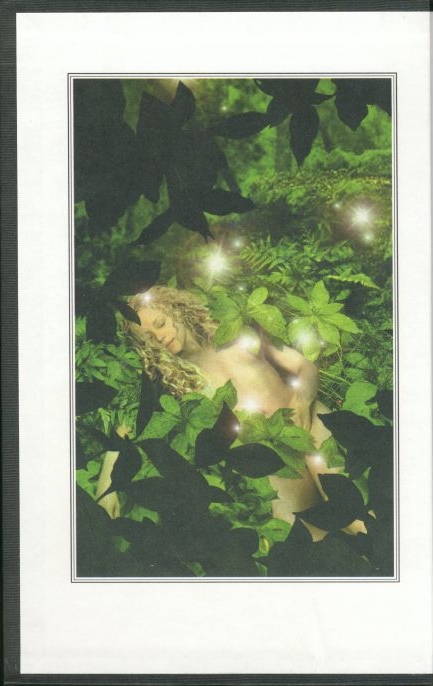
|
|
Herbert's got something on his mind in his latest
novel, 'Once...' Maybe he should have written in....
|
But there's this erotic thing. I guess I have to in fairness
reveal that I prefer experiencing sex to reading about it. Good
erotic writing is very, very difficult, and the bar's been raised by
that most unlikely of sources, 'Letters to Penthouse'. Yes, I've read
some in my time. Trouble is, that once you have -- or even if you've
only read parodies of 'Letters to Penthouse' -- any erotica that is
not mind-blowing art tends to get shuffled over into the next bin
which is LTP. There's no middle ground. Herbert's erotic scenes are,
to give them credit, really good letters. You might think the writer
of these letters had written books before. You might even think 'Hey,
these should be re-written to be included in a novel where they can
stand as erotic scenes'. You'd probably be wrong. Needless to say,
this is not a book you want to hand over to your11 year old who has
gone through Stephen King like nobody's business.
Herbert also has a couple of curious lapses in logic early on, as
if he's not sure how the novel is going to turn out. Benevolent
forces get mix-mastered with malevolent forces in a chase scene that
is otherwise well done. Characters fail to see that wearing the Red
Shirt is not a good thing. Well, it's been done before without too
much of a fuss. His scenes of the happier side of the fairy realm
tend to get a little 'Bambi'-esque. It's a risk you take when you
walk into fairyland. You'd better be ready to fight the good fight
when you're trying to describe the beautifully fantastic. It's a real
trap that can ensnare even the best writers.
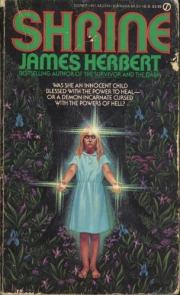
|
|
This well-used paperback version of 'Shrine' is more
in keeping with my experience of james Herbert. Not that
that's a bad thing, mind you...
|
I'd like to be quick to give Herbert his due. I read this novel
because I've read others by him that I particularly enjoyed, in an
'American Cheese' kind of way. I loved
'Domain'. Big ol' rats after the nuclear holocaust is pretty much a
sure-fire formula, and Herbert gets it in one. 'Shrine' was one of
those novels that glued me to chair for couple of days way back when
(probably about the time I was reading 'Faerie Tale', come to think
of it). And 'Once...', in spite of its faults, did pretty much glue
my butt to various chairs and couches in its time. Herbert does know
how to crank up the tension, and keep the pages turning.

|
|
The UK version of this fine novel preceded the
American version. The covers are similar, bu the UK does
give a bigger size to the excellent cover image. Whoever did
the cover image must have actually read the novel, or talked
to someone who did.
|
So 'Drinking Midnight
Wine' by fantasy writer Simon R. Green is left holding the bag.
When I first saw this novel on the bookstore shelf, I took a brief
look at it and said 'Ugh.' Fairy tale oriented horror by a fantasy
writer. Probably not the best formula. But then Penguin Putnam sent
it to me. OK, I'll take another look at it. Maybe I'll read it later.
Only when Andy Fairclough of HorrorWorld
recommended it to me did I unearth it and move it towards the top of
the stack. Mark Ziesing said
he thought I'd like it as well. Closer. Fortunately, I earlier
published my intention to read it and thus sort of forced myself to
do so. It's an absolutely ace novel, number one. It has everything
that many types of genre readers would like. It is an example of the
best that you can do with genre writing, and it straddles horror,
fantasy and even a bit of SF. The book lays flat on the table so you
can read it while eating chicken fried steak. This is what good
writing is all about.

|
|
The US version of this novel has the distinction of
being one of the easiest-to-lay-down-while-eating books I've
ever owned. In my opinion, this is an often overlooked
attribute.
|
Here's what mainly distinguishes 'Drinking Midnight Wine' from
these other works mentioned in this column, besides characters you
really like, very imaginative writing, solid mythological research,
and uniformly trouble-free execution -- a sense of humor. Simon R.
Green made me laugh out loud, several times, actual laughs that would
probably be described as "guffaws". But some "belly laughs" and
"titters" could also be included. Green is capable of being very
funny, and he does so effortlessly enough and often enough that the
reader can look forward tot he next laugh, but still not see it
coming. Now 'Drinking Midnight Wine' is also a bit off the trail that
Feist and Herbert follow. Green expertly puts a few Neil Gaiman
novels in the blender, then adds enough of his own ingredients so
that eventually there's no more Gaiman, only Green. 'Drinking
Midnight Wine' follows slacker/loser bookstore worker Toby Dexter out
of our world ("Veritie") and into "Mysterie". At first I was afraid
that Toby might be the sort of bookstore worker who often inhabits
horror, SF and fantasy novel, that is, one who reads a lot of the
genre. Happily, Toby does not even seem to read a lot. But Green
expertly plots his novel as Toby is drawn towards a Battle Between
Good and Evil of which he will become the focal point.
Green excels I his prose, his humor and his characterizations. His
plot keeps the pages turning, but the better than you'd expect prose
keeps the eyeballs lingering on one good turn of phrase after
another. And Green is savvy enough to write a book that readers of
horror, science fiction or fantasy would all find equally appealing
even if for varying reasons. Admirers of none of those genres might
still find the abundant humor enough to carry them through any
residual distaste caused by genre-exposure. This book doesn't take
itself seriously, though it does take it's characters seriously
enough to make us care, it's plot seriously enough to have it make
sense and its prose seriously enough to slide towards poesy without
use of hammer or really loud trumpets. It's reasonably priced and
readily available.
In other, non-rant-related news, Tor has recently released Paul
McAuley's 'Whole
Wide World' as a domestic hardcover. If you missed the original
column on this book, take a peek, and then give this novel a look as
well. McAuley's got something here of interest, and it's finally
showed up in your local bookstore.
Thanks,
Rick Kleffel








